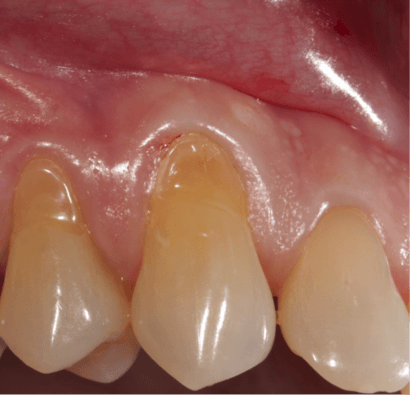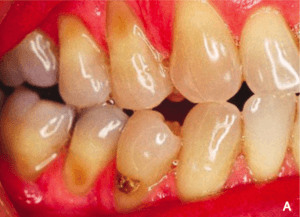Abrasion (dental) facts for kids
Quick facts for kids Abrasion (dental) |
|
|---|---|
 |
|
| Dental abrasion |
Abrasion is when your teeth wear down. This happens because of rubbing against things other than other teeth. It's not caused by cavities. It often affects your premolars (back teeth) and canines (pointy teeth). This wear usually shows up near the gum line. The most common reason for abrasion is brushing your teeth too hard or in the wrong way.
Abrasion often appears where the tooth and gum meet. Many things can cause it, and they can affect your teeth in different ways.
The worn-down area might look different depending on what caused it. Often, it looks like a V-shape. This V-shape is usually from brushing too hard. The surface looks shiny, not like a cavity. Sometimes, the worn area can be deep enough to see the inside of the tooth.
When you have tooth wear from abrasion, it can cause problems. Your teeth might become sensitive to hot and cold. Plaque can build up more easily, leading to cavities or gum disease. It can also make it hard for dental tools like retainers to fit well. For some people, it might also look bad.
To fix abrasion, you first need to find out what's causing it. Then, you need to stop that action, like brushing too hard. After that, treatment might involve changing your brushing habits or toothpaste. A dentist might also put fluoride on your teeth to help with sensitivity. Sometimes, a filling is needed to stop more tooth loss.
Contents
What Causes Dental Abrasion?
Abrasion can happen when your teeth rub against other objects. These can include toothbrushes, toothpicks, or floss. Even dental tools like retainers or dentures that don't fit well can cause it.
Some habits can also increase the risk of abrasion. These include biting your nails or chewing on things. Certain jobs, like being a carpenter who holds nails in their mouth, can also lead to abrasion.
The type of toothpaste you use can also cause abrasion. Some toothpastes are more abrasive, like many whitening toothpastes. Often, dental abrasion is caused by a mix of things. It's usually a combination of rubbing and chemical wear.
Brushing your teeth is the most common cause of dental abrasion. This often happens along the gingival margin (gum line). It's usually from brushing too hard in that area. The type of toothbrush, how you brush, and how much force you use can all affect it. Brushing for too long (more than 2-3 minutes) with medium or hard toothbrushes can cause these worn spots.
Some toothbrushes are more likely to cause abrasion. These are brushes with medium or hard bristles. When you use these bristles with a lot of force, they can scratch your tooth surface. This can also irritate your gums. Repeated irritation to the gum line can make your gums pull back. When gums recede, the tooth root becomes exposed. The root surface is softer and wears down more easily. Electric toothbrushes usually cause less abrasion.
Toothpastes can also damage your enamel and dentin. This is because of their abrasive ingredients. These ingredients help remove stains and plaque. But sometimes, they can make the toothpaste too rough.
Whitening toothpastes are often the most abrasive. This is measured by something called the RDA Scale. Using whitening toothpaste or at-home bleaching kits can increase the chance of abrasion. It's thought that this type of abrasion comes from both rubbing and chemicals. However, if you take good care of your teeth after whitening, you can avoid losing tooth minerals and prevent abrasion.
Changes in the pH levels of your saliva can also play a role. This can happen from sugary or acidic foods and drinks. More acid in your saliva can weaken your tooth structure. This makes your teeth more open to wear from brushing or chewing. When teeth are weakened, brushing can cause lasting damage to the tooth surface. Dental abrasion can get worse and happen faster if you also have Acid erosion.
What is Relative Dentin Abrasivity (RDA)?
Relative dentin abrasivity (RDA) is a way to measure how abrasive a toothpaste is. It tells you how much the toothpaste's ingredients can wear down a tooth.
The RDA scale was created by the American Dental Association (ADA). It compares how much toothpaste wears down dentin to a standard material. A lower RDA value means the toothpaste is less abrasive. Toothpastes with higher RDA values can cause more wear on dentin.
Since 1998, the RDA value follows specific standards. Toothpaste products don't have to show their RDA value by law. However, a toothpaste must have an RDA value lower than 250 to be considered safe for daily use. It also needs to be under 250 to get the ADA seal of approval. The RDA value depends on the size, amount, and surface of the abrasive materials in the toothpaste.
While RDA scores are linked to abrasion, they are not the only factor. Other things also cause dental abrasion. These include how much pressure you use when brushing. The type of toothbrush bristles and how long you brush also matter.
How is Dental Abrasion Treated?
There are several reasons to treat abrasion spots on your teeth. These spots are sometimes called 'Class V cavities'.
- To stop tooth sensitivity.
- If a cavity has also formed in the worn area.
- If the spot looks bad.
- To stop the wear from getting worse.
- To prevent cavities or gum disease. These spots can trap plaque.
- If the spot is deep and might expose the inside of the tooth.
- If it makes it hard for a removable dental appliance, like a denture, to fit.
- To make denture clasps fit better.
- If the tooth's overall strength is weakened.
For successful treatment, you first need to find out what caused the abrasion. A dentist will ask about your health, dental history, habits, and diet. This is because abrasion often has many causes. Once the cause is clear, the right treatment can begin.
Treatment for abrasion can vary. It depends on how much the tooth has worn down. Abrasion often happens with other dental problems. These can include tooth wear from grinding, cavities, or acid erosion. Studies show that fluoride varnish can help reduce the effects of abrasion when combined with acid erosion. Good treatment focuses on stopping the condition from getting worse. It also helps you change the habits that caused it.
Stopping the Causes
If your abrasion is from a habit, you must stop or change that habit. Learning the correct brushing technique is very important. You should use a gentle scrubbing motion with small horizontal movements. Use an extra-soft or soft bristled brush. To avoid brushing too hard, try holding your toothbrush like a pen. Or, use your non-dominant hand to brush. If abrasion is from a dental appliance that doesn't fit, a dentist should fix or replace it. Don't try to fix it yourself at home.
Chemical Treatments
You should also look at your current toothpaste. Switch to a less abrasive and gentler paste, like sensitive toothpaste. Very abrasive toothpastes can cause tooth structure loss. A toothpaste with more fluoride will also help with sensitivity. It also lowers the risk of cavities. Fluoride varnish can help with sensitive teeth. It can also be used to prevent abrasion in people at high risk of acid erosion. This is because fluoride varnish helps the tooth surface.
At the dental office, you might get a fluoride application. For more severe cases, a filling might be placed. If the worn spot is small and only on the enamel or cementum, a filling might not be needed. Instead, the dentist might smooth any rough edges. This helps prevent plaque from sticking. However, if there's a cavity, or if the spot looks bad, or if it's close to the inside of the tooth, a filling may be done. More fillings might be needed if the worn spot weakens the tooth. Or if it causes a gum problem.
Once abrasion is diagnosed and treated, it should be checked regularly. This helps to see if it's getting worse or if your symptoms have improved.
Fillings for Abrasion
When a filling is needed for abrasion, certain materials work best.
- They should resist wear, especially from brushing too hard.
- They should be flexible. Teeth, especially front teeth, can bend a little near the gum line.
- They should look good.
Other good properties for filling materials include:
- Small particles for a smooth finish, which looks better.
- Stiff enough to hold its shape but easy to place in the tooth.
- Can harden on its own or with a light.
- Stays the same size and doesn't shrink much.
- Releases fluoride.
- Sticks well to enamel and dentin.
Common filling materials are amalgam, glass ionomer (GI), resin-modified glass ionomer (RMGI), and resin composite.
Studies show that resin-modified glass ionomer (RMGI) is often the best choice for these fillings. This is true if looks are not the most important thing. Before placing the filling, the surface of the worn area should be roughened. This helps the filling stick better.
See Also
 In Spanish: Abrasión dental para niños
In Spanish: Abrasión dental para niños


